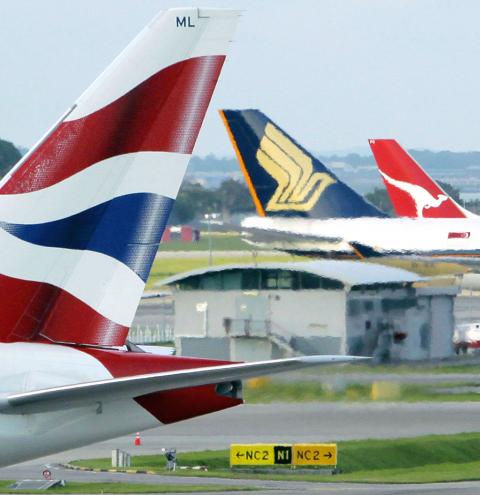Hefty falls in earnings for aviation giants Singapore Airlines Ltd and Emirates are the clearest signs yet of fresh turbulence just three years after the 2008 financial crisis wreaked havoc, analysts said.
The two companies, regarded as among the industry’s most well-managed carriers, cited escalating fuel expenses and growing unease about the global economy as the main drag on profits.
Both airlines rely heavily on intercontinental passenger and cargo traffic to drive earnings and the decline in profits announced on Thursday reflects the severity of the situation facing the sector, analysts said.

Photo: Reuters
“The global airline sector is definitely under pressure right now from both fuel prices and economic volatility,” said Jonathan Galaviz, managing director of Galaviz and Co business consultancy.
“There is no question that the global economic volatility over the last quarter has created heartburn for the global airline industry,” he said.
Singapore Airlines announced on Thursday that net profit in the six months ended September dived 62 percent year-on-year to S$239 million (US$188 million), and cautioned earnings remained under pressure from high fuel prices and anemic global growth.
“The prevailing economic uncertainty and weak consumer confidence are impacting demand for air transportation. Advance passenger bookings are showing signs of weakness, particularly in Europe and the United States,” Singapore Airlines said in a statement. “Forward prices for jet fuel remain high and volatile.”
Singapore Airlines pointed out that yields for air freight, one of several indicators on the state of global commerce, were also expected to be under pressure.
On the same day, Dubai’s Emirates, one of the world’s fastest-growing airlines, reported half-year net profit tanked 76 percent from last year to 827 million dirhams (US$225 million) with higher fuel costs a major culprit.
The state-owned carrier said it had to fork out US$1 billion more for jet fuel compared with the corresponding period in the previous financial year.
Shukor Yusof, an aviation analyst with Standard & Poor’s Equities Research in Singapore, said the outlook for the airline sector appeared cloudy, with the US economy stuck with weak growth and Europe struggling to manage the fallout from Greece’s debt woes.
“We are looking at a severe erosion in not just premium [business and first class] seats, but at the back of the aircraft, which is the economy seats,” he said. “The situation is quite fluid with what is happening in Greece. If Greece disintegrates into something more serious than what we are seeing, then the possibilities are endless in terms of the erosion of airline profitability.”
The International Air Transport Association, which represents about 230 carriers that account for more than 90 percent of scheduled global air traffic, said its members were being hit by a double whammy of high fuel prices and softer global economic conditions.
Jet fuel prices were at US$128 a barrel late last month, 35 percent higher than last year, it pointed out.
“The financial performance of the airline industry is closely linked to the health of world economies. If economic growth is strong airlines can cope with high fuel prices,” it said.
While global air passenger traffic rose 5.6 percent in September from a year ago, that might partly reflect travel booked earlier in the year when there was more economic optimism, the association said.
Air freight contracted 2.7 percent year-on-year in September, its fifth straight month of decline in line with weakening business and consumer confidence, it added.
The last time global airlines ran into turbulence was in the aftermath of the global economic slump that started in late 2008. Global carriers lost US$4.6 billion in 2009, according to the association.
While it is too soon to say whether the new problems will be as deep or long-lasting, the signs are that there is a bumpy ride ahead.

To many, Tatu City on the outskirts of Nairobi looks like a success. The first city entirely built by a private company to be operational in east Africa, with about 25,000 people living and working there, it accounts for about two-thirds of all foreign investment in Kenya. Its low-tax status has attracted more than 100 businesses including Heineken, coffee brand Dormans, and the biggest call-center and cold-chain transport firms in the region. However, to some local politicians, Tatu City has looked more like a target for extortion. A parade of governors have demanded land worth millions of dollars in exchange

An Indonesian animated movie is smashing regional box office records and could be set for wider success as it prepares to open beyond the Southeast Asian archipelago’s silver screens. Jumbo — a film based on the adventures of main character, Don, a large orphaned Indonesian boy facing bullying at school — last month became the highest-grossing Southeast Asian animated film, raking in more than US$8 million. Released at the end of March to coincide with the Eid holidays after the Islamic fasting month of Ramadan, the movie has hit 8 million ticket sales, the third-highest in Indonesian cinema history, Film

Taiwan Semiconductor Manufacturing Co’s (TSMC, 台積電) revenue jumped 48 percent last month, underscoring how electronics firms scrambled to acquire essential components before global tariffs took effect. The main chipmaker for Apple Inc and Nvidia Corp reported monthly sales of NT$349.6 billion (US$11.6 billion). That compares with the average analysts’ estimate for a 38 percent rise in second-quarter revenue. US President Donald Trump’s trade war is prompting economists to retool GDP forecasts worldwide, casting doubt over the outlook for everything from iPhone demand to computing and datacenter construction. However, TSMC — a barometer for global tech spending given its central role in the

Alchip Technologies Ltd (世芯), an application-specific integrated circuit (ASIC) designer specializing in server chips, expects revenue to decline this year due to sagging demand for 5-nanometer artificial intelligence (AI) chips from a North America-based major customer, a company executive said yesterday. That would be the first contraction in revenue for Alchip as it has been enjoying strong revenue growth over the past few years, benefiting from cloud-service providers’ moves to reduce dependence on Nvidia Corp’s expensive AI chips by building their own AI accelerator by outsourcing chip design. The 5-nanometer chip was supposed to be a new growth engine as the lifecycle